

Amphisbaena. Appearance[edit] A 15th-century amphisbaena on a misericord in Buckinghamshire The amphisbaena has a twin head, that is one at the tail end as well, as though it were not enough for poison to be poured out of one mouth.
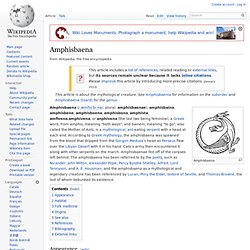
This early description of the amphisbaena depicts a venomous, dual-headed snakelike creature. However, Medieval and later drawings often show it with two or more scaled feet, particularly chicken feet, and feathered wings. Some even depict it as a horned, dragon-like creature with a serpent-headed tail and small, round ears, while others have both "necks" of equal size so that it cannot be determined which is the rear head. Habitat[edit] Amphiptere. An Amphiptere (also called Amphithere, Amphitere, or Phipthere) is a type of winged serpent found in European heraldry.[1] Appearance[edit] Amphipteres generally were said to have greenish-yellow feathers, a serpentine body similar to a lindworm, bat-like green wings with feathered bone, and an arrow-tipped tail much like a wyvern's.
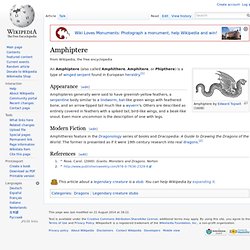
Others are described as entirely covered in feathers with a spiked tail, bird-like wings, and a beak-like snout. Even more uncommon is the description of one with legs. Apep. Development[edit] Ra was the solar deity, bringer of light, and thus the upholder of Ma'at.
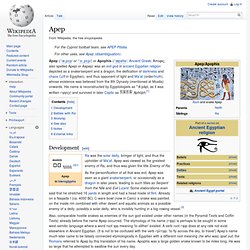
Apep was viewed as the greatest enemy of Ra, and thus was given the title Enemy of Ra. Also, comparable hostile snakes as enemies of the sun god existed under other names (in the Pyramid Texts and Coffin Texts) already before the name Apep occurred. The etymology of his name (ꜥꜣpp) is perhaps to be sought in some west-semitic language where a word root ꜣpp meaning 'to slither' existed. A verb root ꜥꜣpp does at any rate not exist elsewhere in Ancient Egyptian. Zahhak. "Zahak" redirects here.

For the city in southeastern Iran, see Zehak. For the village in Hormozgan Province, see Zahak-e Pain. Zahhāk or Zahāk[1][2] (pronounced [zæhɒːk][3]) (in Persian: ضحاک/ذهاک) or Zohhāk is an evil figure in Iranian mythology, evident in ancient Iranian folklore as Aži Dahāka (Azh dahak), the name by which he also appears in the texts of the Avesta. Bakunawa. Cockatrice. A cockatrice is a mythical beast, essentially a two-legged dragon with a rooster's head.

Echidna (mythology) In Greek mythology, Echidna (Ancient Greek: Ἔχιδνα, "she viper") was half woman half snake, known as the "Mother of All Monsters" because many of the more famous monsters in Greek myth were mothered by her.
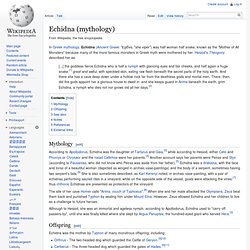
Hesiod's Theogony described her as: [...] the goddess fierce Echidna who is half a nymph with glancing eyes and fair cheeks, and half again a huge snake,[1] great and awful, with speckled skin, eating raw flesh beneath the secret parts of the holy earth. And there she has a cave deep down under a hollow rock far from the deathless gods and mortal men. Fafnir. In Norse mythology, Fáfnir (Old Norse and Icelandic) or Frænir was a son of the dwarf king Hreidmar and brother of Regin and Ótr.
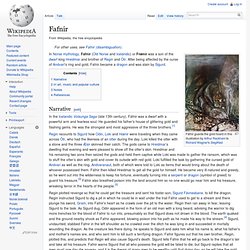
After being affected by the curse of Andvari's ring and gold, Fafnir became a dragon and was slain by Sigurd. Narrative[edit] In the Icelandic Volsunga Saga (late 13th century), Fáfnir was a dwarf with a powerful arm and fearless soul. He guarded his father's house of glittering gold and flashing gems. Feathered Serpent (deity) Aztec era stone sculptures of feathered serpents on display at the National Museum of Anthropology in Mexico City.
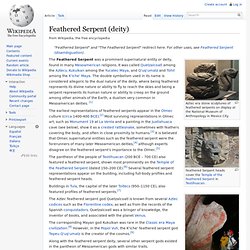
A Feathered Serpent from deep in the Juxtlahuaca cave. Stylistically tied to the Olmec, this red Feathered Serpent has a crest of now-faded green feathers.Courtesy of Matt Lachniet, used with permission. Gorgon. A Gorgon head on the outside of each of the Vix-krater's three handles, from the grave of the CelticLady of Vix, 510 BC In Greek mythology, a Gorgon (plural: Gorgons, Ancient Greek: Γοργών/Γοργώ Gorgon/Gorgo) is a female creature.
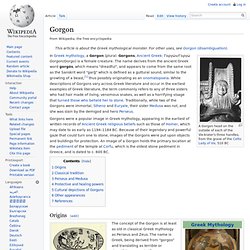
The name derives from the ancient Greek word gorgós, which means "dreadful", and appears to come from the same root as the Sanskrit word "garğ" which is defined as a guttural sound, similar to the growling of a beast,[1] thus possibly originating as an onomatopoeia. While descriptions of Gorgons vary across Greek literature and occur in the earliest examples of Greek literature, the term commonly refers to any of three sisters who had hair made of living, venomous snakes, as well as a horrifying visage that turned those who beheld her to stone. Traditionally, while two of the Gorgons were immortal, Stheno and Euryale, their sister Medusa was not, and she was slain by the demigod and hero Perseus. Hoop snake. According to folklore, the distinguishing feature of a hoop snake is that it can grasp its tail in its jaws and roll after its prey like a wheel,[2][1] thus looking somewhat like the ouroboros of Greek mythology, or Tsuchinoko (a legendary fat snake that can roll like a wheel) in Japan.
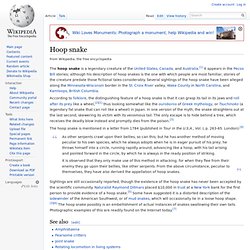
In one version of the myth, the snake straightens out at the last second, skewering its victim with its venomous tail. The only escape is to hide behind a tree, which receives the deadly blow instead and promptly dies from the poison.[3] The hoop snake is mentioned in a letter from 1784 (published in Tour in the U.S.A., Vol. I, p. 263-65. London):[4] Lernaean Hydra. The Second Labour of Heracles[edit] Eurystheus sent Heracles to slay the Hydra, which Hera had raised just to slay Heracles.
Jaculus. In mythology[edit] It was said that the jaculus hid in the trees and sprang out at its victims. The force of it launching itself at the victim led to the association with javelins.[1] Pliny described it as follows: "The jaculus darts from the branches of trees; and it is not only to our feet that the serpent is formidable, for these fly through the air even, just as though they were hurled from an engine. "[2] Aspidochelone. The Aspidochelone lures hapless mariners to land on its back.
According to the tradition of the Physiologus and medieval bestiaries, the aspidochelone is a fabled sea creature, variously described as a large whale or vast sea turtle, and a giant sea monster with huge spines on the ridge of its back. No matter what form it is, it is always described as being huge, often it is mistaken for an island and appears to be rocky, with crevices and valleys with trees and greenery and having sand dunes all over it. The name aspidochelone appears to be a compound word combining Greek aspis (which means either "asp" or "shield"), and chelone, the turtle.
It rises to the surface from the depths of the sea, and entices unwitting sailors with its island appearance to make landfall on its huge shell and then the whale is able to pull them under the ocean, ship and all the people, drowning them. It also emits a sweet smell that lures fish into its trap where it then devours them. Jörmungandr. Sources[edit] The major sources for myths about Jörmungandr are the Prose Edda, the skaldic poem Húsdrápa, and the Eddic poems Hymiskviða and Völuspá. Less important sources include kennings in other skaldic poems. For example in Þórsdrápa, faðir lögseims, "father of the sea-thread", is used as a kenning for Loki. There are also image stones from ancient times depicting the story of Thor fishing for Jörmungandr.
Stories[edit] There are three preserved myths detailing Thor's encounters with Jörmungandr: Lindworm. Lindworm (cognate with Old Norse linnormr 'constrictor snake', Norwegian linnorm 'dragon', Swedish, lindorm, Danish, lindorm 'serpent', German Lindwurm 'dragon') in British heraldry, is a technical term for a wingless bipedal dragon often with a venomous bite. Lamia. Legend of the White Snake. Meretseger. In Egyptian mythology, Meretseger (also spelt Mertseger), meaning "she who loves silence" exerted great authority during the New Kingdom era over the Theban Necropolis and was considered to be both a dangerous and merciful goddess.[1] She was closely connected with al-Qurn, the pyramid-shaped peak in the Valley of the Kings.[2] As a cobra-goddess she is sometimes associated with Hathor.[3]
Mongolian death worm. An interpretation of the Mongolian Death Worm by Belgian painter Pieter Dirkx. The Mongolian death worm (Mongolian: олгой-хорхой, olgoi-khorkhoi, "large intestine worm") is an alleged creature reported to exist in the Gobi Desert. It is generally considered a cryptid: an animal whose sightings and reports are disputed or unconfirmed. It is described as a bright red worm with a wide body that is 2 to 5 feet (0.6 to 1.5 m) long.[1][2] Nāga. Naga stone worship at Hampi. Níðhöggr. Ouroboros. Historical representations[edit] Antiquity[edit] Python (mythology) Rainbow Serpent. Australian Aboriginal rock painting of the "Rainbow Serpent". Names in different cultures[edit] The Rainbow Serpent is known by different names by different Aboriginal cultures. Sea serpent. Tarasque. Tsuchinoko. Wyvern. Yamata no Orochi.